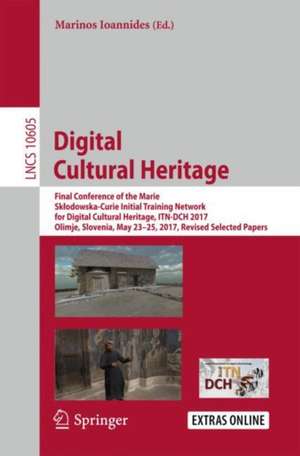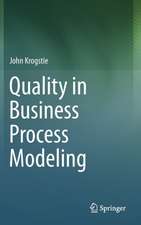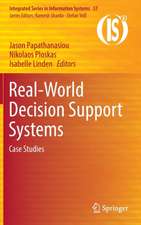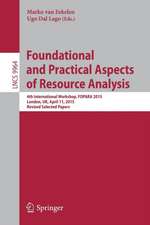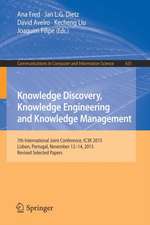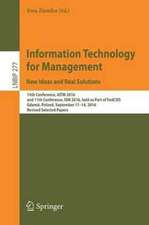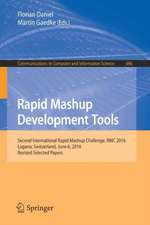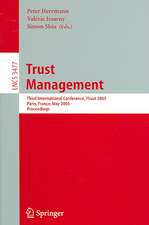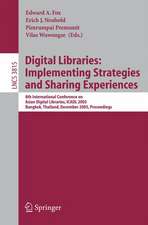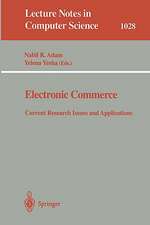Digital Cultural Heritage: Final Conference of the Marie Skłodowska-Curie Initial Training Network for Digital Cultural Heritage, ITN-DCH 2017, Olimje, Slovenia, May 23–25, 2017, Revised Selected Papers: Lecture Notes in Computer Science, cartea 10605
Editat de Marinos Ioannidesen Limba Engleză Paperback – 23 mai 2018
The 29 revised full papers included in this volume were carefully reviewed and selected from 198 submissions. They focus on interdisciplinary and multi-disciplinary research concerning cutting edge cultural heritage informatics, -physics, -chemistry and -engineering and the use of technology for the representation, documentation, archiving, protection, preservation and communication of cultural heritage knowledge.
Din seria Lecture Notes in Computer Science
- 20%
 Preț: 1061.55 lei
Preț: 1061.55 lei - 20%
 Preț: 307.71 lei
Preț: 307.71 lei - 20%
 Preț: 438.69 lei
Preț: 438.69 lei - 20%
 Preț: 579.30 lei
Preț: 579.30 lei -
 Preț: 410.88 lei
Preț: 410.88 lei - 17%
 Preț: 427.22 lei
Preț: 427.22 lei - 20%
 Preț: 596.46 lei
Preț: 596.46 lei - 15%
 Preț: 448.04 lei
Preț: 448.04 lei - 20%
 Preț: 353.50 lei
Preț: 353.50 lei -
 Preț: 389.49 lei
Preț: 389.49 lei - 20%
 Preț: 309.90 lei
Preț: 309.90 lei - 20%
 Preț: 645.28 lei
Preț: 645.28 lei - 20%
 Preț: 763.23 lei
Preț: 763.23 lei - 15%
 Preț: 580.46 lei
Preț: 580.46 lei - 20%
 Preț: 310.28 lei
Preț: 310.28 lei - 20%
 Preț: 655.02 lei
Preț: 655.02 lei - 20%
 Preț: 1183.14 lei
Preț: 1183.14 lei - 20%
 Preț: 340.32 lei
Preț: 340.32 lei -
 Preț: 449.57 lei
Preț: 449.57 lei - 20%
 Preț: 591.51 lei
Preț: 591.51 lei - 18%
 Preț: 938.83 lei
Preț: 938.83 lei - 20%
 Preț: 337.00 lei
Preț: 337.00 lei - 20%
 Preț: 649.50 lei
Preț: 649.50 lei - 20%
 Preț: 607.40 lei
Preț: 607.40 lei - 20%
 Preț: 1414.79 lei
Preț: 1414.79 lei - 20%
 Preț: 1024.44 lei
Preț: 1024.44 lei - 20%
 Preț: 583.40 lei
Preț: 583.40 lei - 20%
 Preț: 453.32 lei
Preț: 453.32 lei - 20%
 Preț: 575.49 lei
Preț: 575.49 lei - 20%
 Preț: 1075.26 lei
Preț: 1075.26 lei - 20%
 Preț: 585.88 lei
Preț: 585.88 lei - 20%
 Preț: 825.93 lei
Preț: 825.93 lei - 17%
 Preț: 360.20 lei
Preț: 360.20 lei - 20%
 Preț: 763.23 lei
Preț: 763.23 lei - 20%
 Preț: 340.32 lei
Preț: 340.32 lei - 20%
 Preț: 504.58 lei
Preț: 504.58 lei - 20%
 Preț: 369.13 lei
Preț: 369.13 lei - 20%
 Preț: 580.93 lei
Preț: 580.93 lei - 20%
 Preț: 343.62 lei
Preț: 343.62 lei - 20%
 Preț: 350.21 lei
Preț: 350.21 lei - 20%
 Preț: 583.40 lei
Preț: 583.40 lei - 20%
 Preț: 583.40 lei
Preț: 583.40 lei - 15%
 Preț: 438.59 lei
Preț: 438.59 lei - 20%
 Preț: 341.95 lei
Preț: 341.95 lei - 20%
 Preț: 238.01 lei
Preț: 238.01 lei - 20%
 Preț: 538.30 lei
Preț: 538.30 lei
Preț: 764.11 lei
Preț vechi: 955.13 lei
-20% Nou
Puncte Express: 1146
Preț estimativ în valută:
146.23€ • 152.10$ • 120.72£
146.23€ • 152.10$ • 120.72£
Carte tipărită la comandă
Livrare economică 14-28 aprilie
Preluare comenzi: 021 569.72.76
Specificații
ISBN-13: 9783319758251
ISBN-10: 331975825X
Pagini: 390
Ilustrații: XIII, 376 p. 191 illus.
Dimensiuni: 155 x 235 mm
Greutate: 0.55 kg
Ediția:1st ed. 2018
Editura: Springer International Publishing
Colecția Springer
Seriile Lecture Notes in Computer Science, Information Systems and Applications, incl. Internet/Web, and HCI
Locul publicării:Cham, Switzerland
ISBN-10: 331975825X
Pagini: 390
Ilustrații: XIII, 376 p. 191 illus.
Dimensiuni: 155 x 235 mm
Greutate: 0.55 kg
Ediția:1st ed. 2018
Editura: Springer International Publishing
Colecția Springer
Seriile Lecture Notes in Computer Science, Information Systems and Applications, incl. Internet/Web, and HCI
Locul publicării:Cham, Switzerland
Cuprins
3D data acquisition and modelling of complex heritage buildings.- Low cost 3D surveying methodologies: colors and dimensional accuracy in the case study of the island of Procida, Italy.- 3D digitization of selected collection items using photometric stereo.- A DICOM-inspired metadata architecture for managing multimodal acquisitions in cultural heritage.- Knowledge management using ontology on the domain of artworks conservation.- Ontology-based data collection for heritage buildings.- Linked open data as universal markers for mobile augmented reality applications in cultural heritage.- Semantic representation and enrichment of cultural heritage information for fostering reinterpretation and reflection on European history.- Digital cultural heritage: semantic enrichment and modelling in BIM environment.- Building information modeling for cultural heritage: the management of a generative process for complex historical buildings.- Innovativebusiness plans for H-BIM application related to alternative financing opportunities for cultural heritage.- 3D models of Ancient Greek collection of the Perm University History Museum.- Towards a digital infrastructure for illustrated handwritten archives.- Anchoring unsorted e-sources about heritage artefacts in space and time.- Using innovative technologies in preservation and presentation of endangered archives.- Analysis, documentation and proposal for restoration and reuse of “Chrysalis” silk factory in Goumenissa, Kilkis, Northern Greece.- The loom: interactive weaving through a tangible installation with digital feedback.- Design of 3D and 4D apps for cultural heritage preservation.- Digital heritage and 3D printing: trans-media analysis and the display of prehistoric rock art from Valcamonica.- The conservation of cultural heritage in conditions of risk with 3D printing on architectural scale.- Virtual reality annotator: a tool to annotate dancers in a virtual environment.- Rapid reconstruction and simulation of real characters in mixed reality environments.- 3D pose estimation oriented to the initialization of an augmented reality system applied to cultural heritage.- Exploring cultural heritage using virtual reality.- 3D visualisation of a woman's folk costume.- The VR kiosk using virtual reality to disseminate the rehabilitation project of the Canadian parliament buildings.- Technologies of non linear storytelling for the management of cultural heritage in the digital city: the case of Thessaloniki.- Minimal functionality for digital scholarly editions.- Digital preservation: how to be trustworthy?.
Caracteristici
Features the state of the art in digital cultural heritage research Presents interdisciplinary and multi-disciplinary research Focuses on e-documentation and e-preservation of cultural heritage
